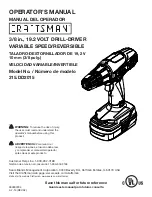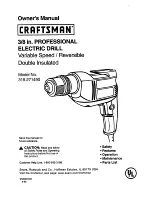
11
10
4. When re-lighting allow five minutes to get previous unburnt
gases out.
5. Once burner is lit, select the correct setting for your food.
NOTE!
If the burner should go out for any reason, turn the control knob
to “OFF” position. Wait 5 minutes before attempting to re-light.
If the grill fails to light after the second attempt, check with your
local dealer for assistance.
With the burner lit, gently close lid and allow the grill to warm up.
IMPORTANT
Flames should be blue and stable with no yellow tips, excessive
noise or lifting. If any of these conditions exist, check to see if air
shutter or burner ports are blocked by dirt, debris, spider webs,
etc. If you have any questions regarding flame stability, please
call customer service.
To adjust for proper flame, use a screw driver to loosen screw. Turn
clockwise to close air shutter, and counter clockwise to open. After
adjusting, tighten screw to fix air shutter.
IMPORTANT
Keep a spray bottle of soapy water near the gas supply valve
and check the connections before each use.
WARNING!
1. Do not light the grill if odour of gas is present, call our
service centre.
2. It is important to ensure that all control valves, including the
gas cylinder, are turned off after use.
USING THE LIGHTING ROD
Check to be sure all openings into grill body are free of blockages
or debris. Make sure there are no objects or materials blocking
the flow of combustion or ventilation. Make sure the feet are in the
down position when using the grill.
1. Use the lighting rod located on the left side of your table top
grill. See the following figure.
2. Attach the match to the front end of the lighting rod, light
match and stick the lighting rod into the access first prior to
turning on the gas.
Lighting Rod
Access for manual lighting
Showing match fitted to lighting rod for manual lighting.
TURNING OFF GRILL
1. With lid open, turn valve control knob to “OFF”
2. Caution: Do not attempt to re-light without following all lighting
instructions.
3. Allow grill body to cool at least 30 minutes before attempting to
move or transport.
MOVING INSTRUCTIONS
WARNING!
Never move grill with burner lit.
TRANSPORTING GRILL
Make sure gas control is off and grill has cooled for at least 30
minutes. Disconnect cylinder from regulator. Remove valve &
regulator from grill. Close lid and secure latch. Place feet in closed
position. Carry grill by handle.
NOTE!
It is best to leave the grease pan in place attached to the bottom
of the grill – some grease may continue to drop from the grill
during transport.
COOKING INSTRUCTIONS
NOTE!
PREPARATION BEFORE COOKING
To prevent foods from sticking to the cookware, please use a
long handled brush to apply a light coat of cooking or vegetable
oil before each barbecuing session.
1. Allow grill to warm up with lid closed prior to cooking. Cook
with lid open
2. This grill model is quipped with an adjustable HIGH/MED/LOW
burner control. This allows for complete flexibility in cooking
temperatures.
HIGH setting has a cooking temperature of approximately 230
degrees C.
MED is approximately 200 degrees C.
LOW is approximately 175 degrees C.
3. The cooking times we suggest are only that – suggestions. You
may want to vary the times as you become used to your grill.
4. You may cook on the grill in any weather. If the temperature is
extremely cold or hot, it will slightly increase or decrease your
cooling times. Keep grill out of excessive wind when operating,
as it may increase cooking times.
GRILLING
1. T-Bone Steak, thick medium: grill 10 minutes on each side at
MED setting.
2. Chicken Quarters, average size fryer: Cook skin side up for
30 minutes, skin side down for 30 minutes at MED setting.
Check for doneness. If chicken is completely done, only then
drip or brush on sauce of your choice. Put back on grill for
approximately 10 minutes longer. You may want to repeat this
process one or two more times.
3. Pork ribs and pork chops; grill 10-20 minutes each side, MED
setting. When done, drip or brush on sauce. Put back on grill
for 5-10 minutes. Repeat if desired.
NOTE!
Above times are a guide only and are not for frozen meats.
Frozen food should be thawed correctly prior to cooking.
ROASTING HOOD COOKING
Barbecues equipped with a roasting hood give the option of
cooking with hood closed to form an ‘oven’ for roasting food, such
as joints of meat, whole chickens, etc.
WARNING!
Cooking with the hood closed and the burner on high creates a
fire risk.
When the hood is closed, a large amount of heat is trapped inside
the barbecue. Thus, it is IMPORTANT to make sure that the burner
is turned to the low position to prevent burning of the food and
damaging the barbecue. Avoid lifting the hood unnecessarily as
heat is lost every time the hood is opened. DO NOT ALLOW YOUR
BARBECUE TO OVERHEAT. A BARBECUE SHOULD NEVER BE
LEFT UNATTENDED WHILE COOKING!
FLARE-UP CONTROL
Flare-ups occur when meat is barbecued, and its fats and juices fall
upon the burner. The smoke from some flare-up helps give cooked
meat its barbecued flavour, but excessive flare-up will result in
meat being burned. To control flare-up, it is advisable to trim away
excess fat from meat and poultry before grilling. Also, the burner
should always be placed on the low setting during cooking. Finally,
extinguish flare-up by applying baking soda or salt directly onto the
area. Always protect your hands when handling anything near the
cooking surface of the barbecue.
If a fat fire should occur in the drip tray, turn the knob to the off
position, turn off the gas at the bottle, and wait for the fire to go out.
Do not pull out the drip tray or douse with water.
END OF THE COOKING SESSION
After each cooking session, turn the BBQ burner to the “HIGH”
position and burn off for 5 minutes. This procedure will burn off food
residue, thus making cleaning easier.
TURNING OFF YOUR BARBECUE
When you have finished using your barbecue, turn off the gas at the
bottle and turn all the control valve fully to the “OFF” position. Wait
until the barbecue is sufficiently cool before closing its hood. Once
cooled, a protective cover* should always be fitted to the barbecue
to protect your investment from the elements when not in use.
*Optional extra: 558843 - Barbecue cover
CARE AND MAINTENANCE
There is very little care and maintenance needed. The grill is
designed and made of materials that will last many years with
normal use. Following these instructions will improve the longevity
and quality of cooking. To ensure safe operation of your grill, the
cooking area should always be kept free of combustible materials of
any type, such as gasoline or other flammable vapours or liquids.
1. Outside of body – This is stainless steel. It can be cleaned
easily with warm soapy water or any stainless steel cleaner.
2. Grid and drip pan – The grid is made of high quality stainless
steel. The grid should be brushed with a brass or stainless steel
brush immediately after removing food, while grill is still warm.
The drip pan must be kept clean and free of heavy build-up
for grill to perform properly and to eliminate flare-ups. Drip pan
should be washed completely clean.
3. Inside grill – use soapy water to clean this area. Do not allow
grease to build up.
4. Drain pipe – Drain pipe must be kept clear of grease and food
particles to allow grease to drain properly from drip pan. This
must be done to maintain proper operation of your grill.
5. General, This grill, like all equipment, will look better and last
longer if kept out of weather when not in use. Caution: Do not
store gas cylinders in enclosed spaces. When moving the grill;
always wait until grill has cooled for at least 30 minutes.
6. When grill is not in use, turn valve knob to “OFF”, remove the
gas cylinder from regulator. If the grill is stored indoors, detach
cylinder and leave it outdoors. Cylinders must be stored out of
reach of children.
Regularly clean your barbecue between uses and especially
after extended periods of storage. Ensure the barbecue and its
components are sufficiently cool before cleaning. Do not leave the
barbecue exposed to outside weather conditions or stored in damp,
moist areas.
• Never douse the barbecue with water when its surfaces are hot.
• Never handle hot parts with unprotected hands.
• Check that burners are extinguished before disconnecting the gas
cylinder.
• Check the gas cylinder is empty before removing it.
• Change the gas container outside and away from people.
• Check the seal visually, before connecting a new gas container to
the appliance.
Whilst our products are made to the highest standards and all care
is taken to make them as weather proof as possible, we cannot
accept responsibility for rust occurring on exposed metal parts
unless this is a result of faulty manufacture or parts.
In order to extend the life and maintain the condition of your
barbecue, we strongly recommend that the unit is covered when
not in use, especially during the winter months.
STAINLESS STEEL CARE AND CLEANING ADVICE
Cleanliness and stainless steel are closely related. Stainless steel
performs best when clean - cleanliness is essential for maximum
resistance to corrosion and to maintain the good looks and life of
your BBQ.
TYPES OF SURFACE CONTAMINANTS
Fingerprints and Stains
Fingerprints and mild stains resulting from normal use are the most
common surface contaminates. They can be removed with a glass
cleaner or with a soft rag. This should be followed by a thorough
warm water rinse.
Dirt
Like any surface that is exposed to the environment especially in
coastal areas, stainless steel can get dirty. Cleaning with warm
water with or without a gentle detergent is sufficient. Next in
order are mild non-scratching abrasive powders such as typical
household cleaners. These can be used with warm water, bristle
brushes, sponges, or clean cloths. Carbon steel brushes or steel
wool should be avoided as they may leave particles embedded on
the surface which can lead to RUSTING. Cleaning should always be
followed by rinsing in clean hot water.
Grease
Grease may soil stainless steel surfaces in food preparation. These
soils may be mildly corrosive if left or may not allow the surface
to maintain passivity, and so regular removal is a necessity for the
appearance.
TYPES OF CLEANERS AND METHODS
Consider the possibility of scratching and the potential for post-
cleaning corrosion caused by incompletely removed cleaners. Avoid
using abrasive cleaners unless absolutely necessary.
Clean Water and Wipe
A soft cloth and clean warm water should always be the first choice
for mild stains and loose dirt and soils. A final rinse with clean
water and a dry wipe will complete the process and eliminate the
possibility of water stains.
Household Cleaners
Household cleaners fall into two categories: detergent (non-
abrasive) and abrasive cleaners. Abrasive cleaners are more
effective but introduce the possibility of scratching the surface. A



























